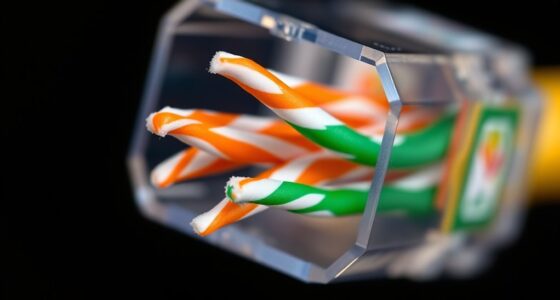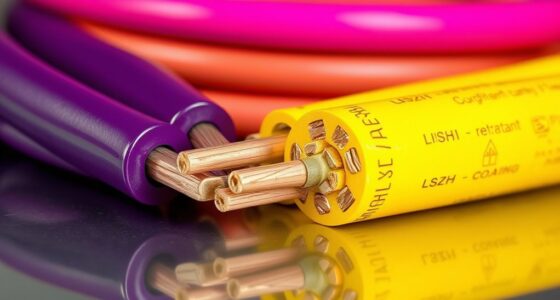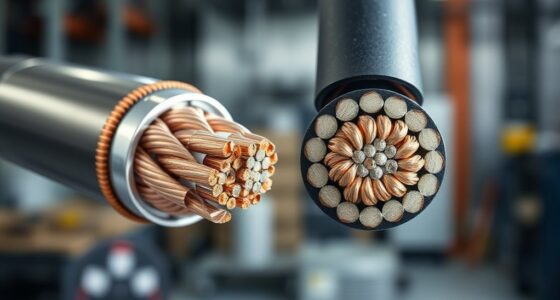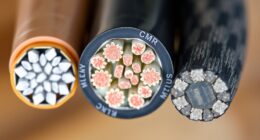Ethernet patch cables are crucial tools that connect devices within your network for fast, reliable data transfer. They support wired connections that are more stable and less interference-prone than wireless options, helping safeguard your network’s security. Depending on your needs, you might choose different cable types like Cat6 or fiber optic for higher speeds or long distances. To guarantee maximum performance, selecting the right cable and following best practices is necessary—learn more to enhance your setup.
Key Takeaways
- Ethernet patch cables connect devices within a network to enable reliable wired data transfer.
- They come in various categories (e.g., Cat5e, Cat6) suited for different speeds and bandwidth needs.
- Use patch cables for connecting computers, routers, switches, or patch panels in homes and offices.
- Choose the right cable length and shielding to prevent interference and ensure optimal performance.
- Proper management and regular inspection extend cable lifespan and maintain network reliability.
What Are Ethernet Patch Cables?
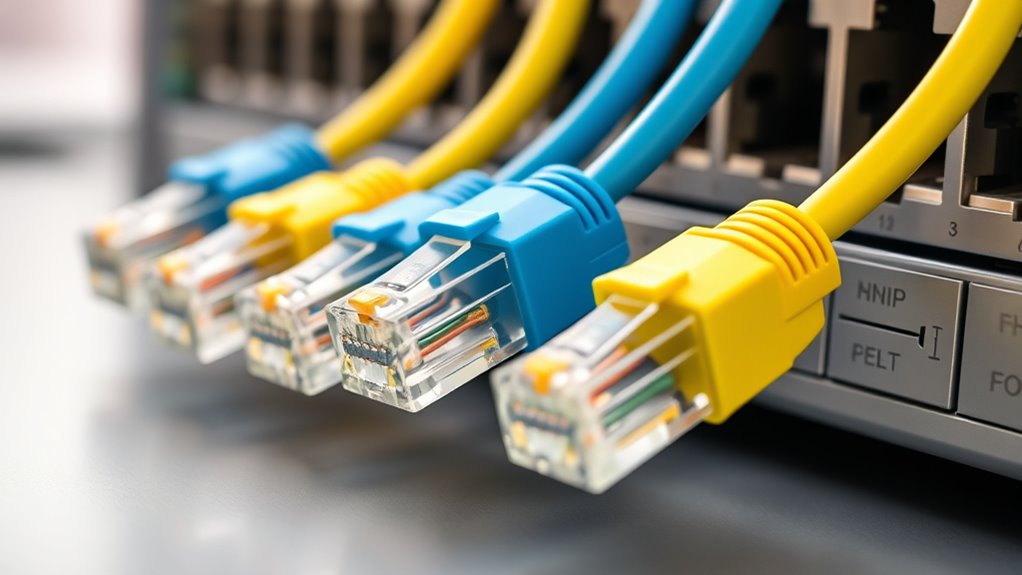
Ethernet patch cables are indispensable tools for connecting devices within a network, allowing data to flow smoothly between computers, routers, switches, and other hardware. These cables enable wired connections that are often more reliable than wireless connectivity, providing stable data transfer and reducing interference. While wireless options are convenient, Ethernet patch cables help maintain network security by limiting exposure to potential wireless threats. They also support faster, more consistent speeds, which is crucial for data-intensive tasks. By directly linking network components, these cables ensure your setup remains secure, reducing the risk of unauthorized access. Additionally, retail hours can influence the availability of Ethernet cables and accessories at local stores. Properly managing user privacy and data protection is essential when setting up and maintaining network infrastructure. Incorporating high-quality cables can also prevent signal degradation and network disruptions, ensuring optimal performance. Investing in certified cables can further enhance connection reliability and reduce potential issues. Overall, Ethernet patch cables are fundamental for building a secure, high-performance network infrastructure, especially when reliable connectivity and enhanced security are priorities.
Key Features and Specifications of Ethernet Patch Cables

Understanding the key features and specifications of Ethernet patch cables is essential for selecting the right cable for your network needs. These cables vary in bandwidth, shielding, and connector types, impacting speed and reliability. For high-speed connections, look for cables supporting Gigabit Ethernet or higher. Shielded cables reduce interference, especially in environments with fiber optics or wireless alternatives nearby. The cable’s category (Cat5e, Cat6, Cat6a) indicates performance level. Additionally, connector quality and length affect signal integrity. Choosing the right patch cable guarantees superior network performance, and familiarity with industry standards ensures compatibility and optimal functionality. Here’s a quick overview:
| Feature | Specification | Impact |
|---|---|---|
| Bandwidth | Up to 10 Gbps | Faster data transfer |
| Shielding | UTP, STP, FTP | Reduces interference |
| Category | Cat5e, Cat6, Cat6a | Determines speed and frequency |
Different Types of Ethernet Patch Cables and Their Uses

There are several types of Ethernet patch cables designed for specific environments and performance needs. For high-speed connections over longer distances, fiber optic patch cables are ideal, offering faster data transfer and immunity to electromagnetic interference. These are often used in data centers or backbone connections. Cat5e and Cat6 cables are common for standard networking, suitable for most home or office setups. If you’re connecting devices wirelessly, such as using wireless adapters, Ethernet patch cables can provide a reliable wired connection when Wi-Fi isn’t enough. Shorter patch cables are perfect for linking devices within a rack or between nearby equipment. Choosing the right type depends on your environment and speed requirements, ensuring suitable performance and connectivity. Additionally, understanding the Culinary Uses of Chia Seeds can help you incorporate nutritious options into your diet, emphasizing the importance of selecting the appropriate tools and materials for your specific needs. Proper cable management can also improve the longevity and safety of your network setup, preventing damage and disconnections. To optimize your setup, consider proper installation techniques that ensure secure and efficient connections. Furthermore, paying attention to compatibility with network hardware ensures that your cables will perform as expected without issues.
How to Choose the Right Ethernet Patch Cable for Your Network
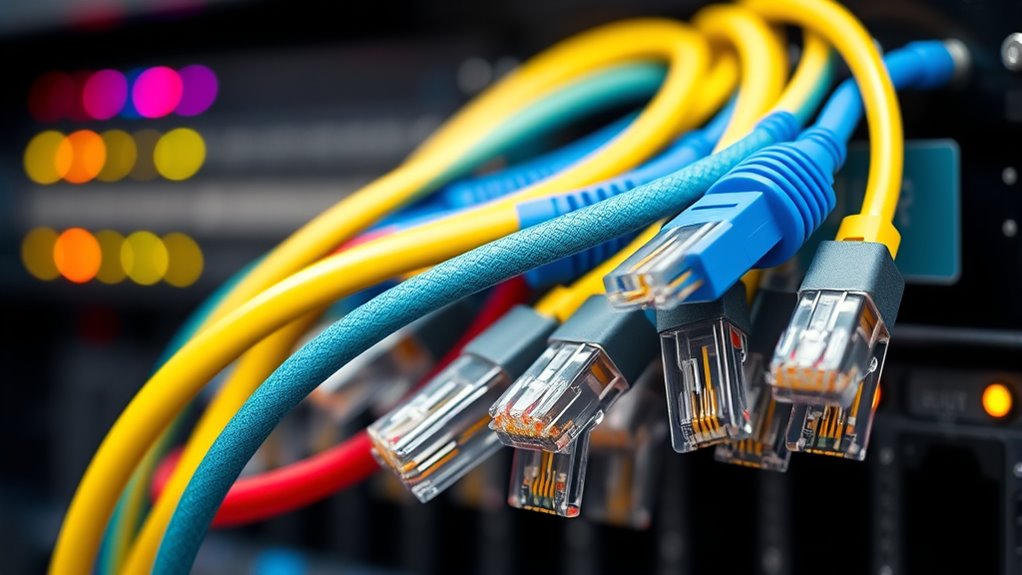
Choosing the right Ethernet patch cable depends on evaluating your network’s specific needs and environment. First, consider cable durability—if your setup involves frequent movement or harsh conditions, opt for cables with reinforced jackets or shielding to prevent damage. Compatibility considerations are equally important; make sure the cable’s connector type and category match your network equipment’s specifications. For high-speed applications, select cables rated for your desired bandwidth, like Cat6 or Cat7. Additionally, think about the length you need to avoid excess slack that can cause tangles or signal interference. By focusing on durability for your environment and verifying compatibility with your devices, you’ll choose a patch cable that ensures reliable performance and longevity for your network.
Best Practices for Connecting and Maintaining Ethernet Patch Cables

To guarantee your Ethernet patch cables perform reliably over time, it’s essential to follow proper connection and maintenance practices. Good cable management prevents tangling and reduces damage, ensuring consistent performance. Regularly inspect your cables for wear or loose connections. Keep troubleshooting tips in mind: if you experience slow speeds or connection drops, check for damaged cables or improper connections first. Additionally, understanding cable maintenance can extend the lifespan of your network setup and prevent common issues. Being aware of juice detox side effects can help you recognize potential problems early if you are also engaging in health-related routines, ensuring a balanced approach to overall well-being. Proper handling and cable organization are crucial in maintaining optimal network performance and avoiding disruptions. Incorporating regular testing of your network connections can help identify issues before they impact your workflow.
Frequently Asked Questions
Can Ethernet Patch Cables Support High-Speed Internet Connections?
Yes, Ethernet patch cables can support high-speed internet connections like Gigabit speeds. To guarantee ideal performance, you might need cable upgrades if your current patch cables are outdated or of lower category. Using higher-category cables, such as Cat 6 or Cat 6a, helps achieve faster speeds and reliable connections, making them suitable for modern high-bandwidth activities. Always choose the right cable for your network needs to maximize performance.
Are There Differences in Durability Between Indoor and Outdoor Ethernet Patch Cables?
You’ll notice indoor and outdoor ethernet patch cables differ in durability, primarily due to environmental resistance. Outdoor cables are designed with tougher insulation to withstand moisture, UV rays, and temperature fluctuations, addressing durability concerns. Indoor cables, meanwhile, focus on flexibility and ease of installation, but they lack the environmental resistance needed for harsh conditions. So, select outdoor cables for durability concerns and outdoor environments to guarantee longevity and reliable connections.
How Do I Identify the Correct Connector Type for My Device?
To identify the correct connector type for your device, first check its port. Most Ethernet devices use RJ45 connectors, but some may require different types like RJ11 or specialty connectors. confirm the connector matches your device’s port for compatibility. Look at your device’s specifications or consult the user manual to confirm connector types, so you select a patch cable compatible with your device and ensure reliable network connections.
What Is the Typical Lifespan of an Ethernet Patch Cable?
An Ethernet patch cable usually lasts about 8 to 10 years, but cable degradation and lifespan factors can shorten this. You should replace it if you notice frequent disconnections, slow speeds, or visible damage. Environmental conditions like excessive heat, moisture, or bending also impact longevity. Regularly inspecting your cable helps you catch early signs of wear, ensuring your network stays reliable and efficient over time.
Can Ethernet Patch Cables Be Repaired if Damaged?
When your Ethernet patch cable gets damaged, don’t bother with repair—it’s often unreliable. Instead, opt for cable replacement to guarantee consistent performance. While cable repair might seem tempting, it can cause more issues, like signal loss or interference. Think of it as patching a leak versus replacing a broken pipe. For dependable network connections, replacing the damaged cable is your best bet for quality and peace of mind.
Conclusion
Remember, a chain is only as strong as its weakest link. Choosing the right Ethernet patch cable guarantees a reliable, high-speed connection for your network. Properly connecting and maintaining your cables extends their lifespan and keeps your data flowing smoothly. By understanding the different types and features, you can make informed decisions. Don’t wait for issues to arise—invest in quality now and keep your network running seamlessly, because a well-connected system is a well-functioning one.


